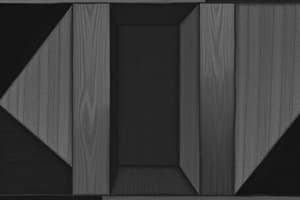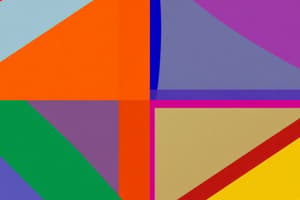Podcast
Questions and Answers
A quadrilateral with both pairs of opposite sides parallel is called a ______.
A quadrilateral with both pairs of opposite sides parallel is called a ______.
parallelogram
In a parallelogram, all four angles are congruent.
In a parallelogram, all four angles are congruent.
False (B)
Match the following properties with their corresponding quadrilateral type:
Match the following properties with their corresponding quadrilateral type:
Opposite sides are congruent = Parallelogram All angles are right angles = Rectangle All sides are congruent = Rhombus All sides are congruent and all angles are right angles = Square
Which of the following is NOT a property of a parallelogram?
Which of the following is NOT a property of a parallelogram?
If two opposite angles of a quadrilateral are congruent, is it necessarily a parallelogram? Explain your answer.
If two opposite angles of a quadrilateral are congruent, is it necessarily a parallelogram? Explain your answer.
In a parallelogram, consecutive angles are ______.
In a parallelogram, consecutive angles are ______.
Which of the following conditions is sufficient to prove that a quadrilateral is a parallelogram?
Which of the following conditions is sufficient to prove that a quadrilateral is a parallelogram?
Which of the following conditions is NOT a requirement for a quadrilateral to be a parallelogram?
Which of the following conditions is NOT a requirement for a quadrilateral to be a parallelogram?
If two opposite angles in a quadrilateral are congruent, then the quadrilateral must be a parallelogram.
If two opposite angles in a quadrilateral are congruent, then the quadrilateral must be a parallelogram.
What is the sum of two consecutive angles in a parallelogram?
What is the sum of two consecutive angles in a parallelogram?
A parallelogram can be divided into two congruent ______ by drawing a diagonal.
A parallelogram can be divided into two congruent ______ by drawing a diagonal.
Match each property with the corresponding characteristic that guarantees a quadrilateral is a parallelogram:
Match each property with the corresponding characteristic that guarantees a quadrilateral is a parallelogram:
Which of the following is TRUE about the diagonals of a parallelogram?
Which of the following is TRUE about the diagonals of a parallelogram?
If a quadrilateral has two pairs of congruent sides, it must be a parallelogram.
If a quadrilateral has two pairs of congruent sides, it must be a parallelogram.
What is the term used to describe the point where the diagonals of a parallelogram intersect?
What is the term used to describe the point where the diagonals of a parallelogram intersect?
If a quadrilateral has two adjacent angles that are ______, then it must be a parallelogram.
If a quadrilateral has two adjacent angles that are ______, then it must be a parallelogram.
The diagonals of a rhombus bisect each other.
The diagonals of a rhombus bisect each other.
Which of the following is NOT a characteristic of a rectangle?
Which of the following is NOT a characteristic of a rectangle?
In parallelogram RUBY, ∠R = 115°. What is the measure of ∠U?
In parallelogram RUBY, ∠R = 115°. What is the measure of ∠U?
A quadrilateral with two pairs of congruent sides is a ______.
A quadrilateral with two pairs of congruent sides is a ______.
Match the special parallelograms to their defining characteristics:
Match the special parallelograms to their defining characteristics:
If the diagonals of a quadrilateral bisect each other, what type of quadrilateral must it be?
If the diagonals of a quadrilateral bisect each other, what type of quadrilateral must it be?
In parallelogram ROAD, RM = 2y - 1 and MA = y + 2. Solve for y.
In parallelogram ROAD, RM = 2y - 1 and MA = y + 2. Solve for y.
A parallelogram with one right angle is a square.
A parallelogram with one right angle is a square.
The diagonals of a rectangle are ______.
The diagonals of a rectangle are ______.
Flashcards
Quadrilateral
Quadrilateral
A closed plane figure with four sides and four angles.
Convex Quadrilateral
Convex Quadrilateral
A quadrilateral where the diagonals intersect.
Parallelogram
Parallelogram
A quadrilateral with both pairs of opposite sides parallel.
Properties of Parallelogram
Properties of Parallelogram
Signup and view all the flashcards
Opposite Sides
Opposite Sides
Signup and view all the flashcards
Consecutive Angles
Consecutive Angles
Signup and view all the flashcards
Diagonals
Diagonals
Signup and view all the flashcards
Parallelogram Conditions
Parallelogram Conditions
Signup and view all the flashcards
Opposite Angles Congruent
Opposite Angles Congruent
Signup and view all the flashcards
Supplementary Adjacent Angles
Supplementary Adjacent Angles
Signup and view all the flashcards
Diagonal Bisection
Diagonal Bisection
Signup and view all the flashcards
Matching Triangles
Matching Triangles
Signup and view all the flashcards
Opposite Sides Parallel
Opposite Sides Parallel
Signup and view all the flashcards
Angle Relationships
Angle Relationships
Signup and view all the flashcards
Congruent Opposite Angles
Congruent Opposite Angles
Signup and view all the flashcards
Diagonal Midpoint
Diagonal Midpoint
Signup and view all the flashcards
Rhombus
Rhombus
Signup and view all the flashcards
Rectangle
Rectangle
Signup and view all the flashcards
Square
Square
Signup and view all the flashcards
Conditions for Parallelogram
Conditions for Parallelogram
Signup and view all the flashcards
Supplementary Angles
Supplementary Angles
Signup and view all the flashcards
Opposite Angles
Opposite Angles
Signup and view all the flashcards
Diagonals of Parallelogram
Diagonals of Parallelogram
Signup and view all the flashcards
Theorem of Right Angles
Theorem of Right Angles
Signup and view all the flashcards
Study Notes
Quadrilaterals
- A quadrilateral is a closed plane figure with four sides and four angles.
- A convex quadrilateral has intersecting diagonals.
- A non-convex quadrilateral has non-intersecting diagonals.
- Parallel lines are lines that never intersect.
- Intersecting lines are lines that cross each other.
Parallelograms
- A parallelogram is a quadrilateral with both pairs of opposite sides parallel.
- Opposite sides are congruent (equal in length).
- Opposite angles are congruent.
- Consecutive angles are supplementary (add up to 180 degrees).
- Diagonals bisect each other.
Special Parallelograms
- Rectangle: A parallelogram with four right angles.
- Rhombus: A parallelogram with four congruent sides.
- Square: A parallelogram with four congruent sides and four right angles.
- A trapezoid is a quadrilateral with at least one pair of parallel sides
- A trapezium is a quadrilateral with no parallel sides.
- A kite is a quadrilateral with two pairs of adjacent sides that are congruent.
Theorems
- Equal opposite sides are sufficient for a quadrilateral to be a parallelogram.
- A single pair of congruent and parallel sides is sufficient to classify a quadrilateral as a parallelogram.
- Diagonals that bisect each other are sufficient to identify a quadrilateral as a parallelogram.
- A quadrilateral with equal opposite angles is always a parallelogram.
- A quadrilateral with any two consecutive angles adding up to 180 degrees is a parallelogram.
Diagonals
- Diagonals of a parallelogram bisect each other.
- Diagonals of a square are perpendicular and equal in length
- Diagonals of a rectangle are equal in length
- Diagonals of a rhombus are perpendicular.
Properties of Special Parallelograms (Theorems)
- A square's diagonals are perpendicular and are equal in length.
Studying That Suits You
Use AI to generate personalized quizzes and flashcards to suit your learning preferences.




